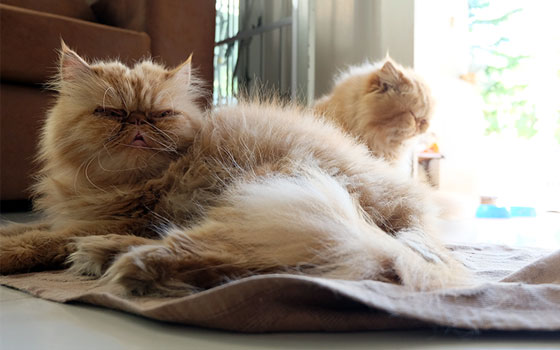Lifespan
12 to 15+ years
By : Trupanion Staff | Updated Feb 14, 2024
Lifespan
12 to 15+ years
Weight
7 - 15 pounds
Energy level
Mellow fellow

An Exotic Long Hair cat is sweet and affectionate, with a playful side too. Often you find them entertaining themselves with whatever they can find, like a balled-up piece of paper. But they’ll happily engage in playtime with their people, especially if you have something they can chase.
Their American Shorthair parentage makes them a bit more outgoing and active, while the Persian in them means they’re quite content cuddling on the couch all day.
The Exotic might be a bit reserved when meeting new people and may hide when there’s lots of activity in the home but will warm up if given a bit of time and space to check things out on their own terms.
Exotic Long Hair cats (much like Exotic Shorthair and Persian cats) have a low activity level and are extremely docile but can be very playful and affectionate with their guardians. They also need a fair amount of attention from their favorite people, so expect them to follow you around.
These kitties bring a calm and relaxed attitude into the home and enjoy plenty of cuddles and lap-time. They have a dense coat that traps heat close to the body, so Exotic Long Hairs enjoy finding cool places to “chill out”, including tile and brick floors; it’s advisable to have a home with air-conditioning.
They are great for people who enjoy having an affectionate cat to spend time with, and those who have time to spend on daily grooming. Because they prefer to be around people, they’re best off in a home where their guardians are not frequently away for long periods of time.
The Exotic Long Hair cat made its debut on the cat scene in the mid 20th century, along with their siblings the Exotic Shorthairs. American Shorthair breeders wanted to cross their breed with Persians to obtain an American Shorthair with a silver coat, emerald eyes, and blockier body type. The intent was to create a “Sterling,” named for the sterling silver coat. Things didn’t go quite as planned, but the resulting mix of coat colors was too much to resist, especially when paired with the new breed’s overall cuteness.
The American Shorthair Breeders also used Russian Blues and Burmese crossed with Persians early on, to try and keep the coat length shorter. But these long-coated breeds injected their genetics and are the reason we have the Exotic Long Hair cat.
The new Exotic breed was officially recognized in 1966 by the Cat Fanciers’ Association and easily gained popularity throughout the world. Crossing the breed with Russian Blues and Burmese was allowed until the year 1987 when the CFA decided to only allow crossing with Persians. Exotic kittens with a long coat are known as Exotic Long Hairs but are also recognized by many registries as Persians.
Exotic Long Hair cats are laid-back and easy-going and are tolerant of children and other pets. If younger children are taught how to gently handle cats, and other pets don’t play too roughly with them, this breed should get along with everyone just fine.
The Exotic Long Hair needs exercise to keep from becoming overweight, and their love of play makes it easy. They especially like chasing toys, so using a fishing-pole style toy to entice them to run and pounce will do wonders to keep them in shape.
These cats enjoy their lap-time and naps, but that doesn’t mean that they don’t have a need for entertainment to keep their minds active and healthy. It doesn’t take much to serve as enrichment for this breed, who can be kept busy with catnip mice and other small toys. Kittens have retained the hunting instinct from the American Shorthair so play sessions with a wand toy and prey-like lures will be fun and appreciated. This breed likes to be around their human guardians to see what they are doing, so be sure to provide them with plenty of spots, like stools or shelves, so they can keep an eye on you.
The Exotic Long Hair cat has the same personality as the Persian - laid-back, docile, playful, and not terribly active. They also have a hunting instinct from their American Shorthair ancestors. Give these activities a try:
The Exotic has a thick, multi-layered coat, just like a Persian. Daily brushing is recommended to keep the fur and skin healthy and to prevent matting and furballs.
The Exotic cat also tends to shed more during seasonal shedding periods and will benefit from more frequent brushing during these times. Some Exotic Long Hair cat owners prefer to have their cat bathed and groomed professionally to help with the grooming upkeep of this breed.
The flat face of the Exotic long hair cat requires frequent cleaning to prevent infections from developing in the skin folds and keep them comfortable.
Brachycephalic cats are less tolerant of upper respiratory infections, in that their respiratory system is already compromised and infection/inflammation worsens it. Be very observant and proactive with keeping your cat's nostrils clear of any discharge should a respiratory infection set in.
As with all cat breeds, Exotic long hair cats also need twice-monthly nail trimming, regular teeth brushing and yearly well pet veterinary checkups to stay happy and healthy. Introduce your kitten to these experiences at a young age, keeping the experience calm and positive.